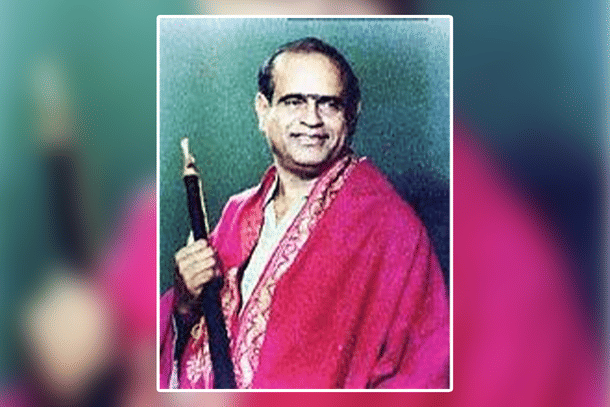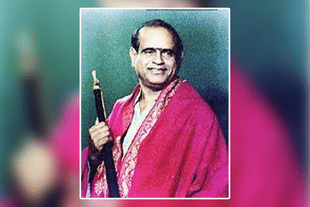Culture
Sheik Chinna Moulana And His Music Adhered To The Sanatana Ideals Of Southern India
K Balakumar
May 12, 2024, 03:33 AM | Updated 06:04 PM IST
Save & read from anywhere!
Bookmark stories for easy access on any device or the Swarajya app.


There is a short video clip of Ilaiyaraaja now doing its rounds on social media platforms, and in which the famed music director speaks about the greatness of the nagaswaram as a musical instrument. Saying that there is no musical instrument like nagaswaram in the world, Ilaiyaraaja describes it as a cultural symbol of this country.
And one of the true maestros of that instrument who understood both its musical and cultural significance was Sheik Chinna Moulana Sahib, whose centenary year kicks off from May 12 (he was born May 12, 1924).
Chinna Moulana Sahib, born into a Muslim family (in the Prakasam district of Andhra Pradesh) that is nurturing the great tradition of nagaswaram for over 300 years, all through his life remained a great ambassador of Carnatic and temple music, and for religious syncretic ideals that South India has been always known for.
‘Sangita Kainkaryam’ was a term that he often referred to till he was alive (he passed away in 1999). It roughly translates to 'musical duty', and Chinna Moulana Sahib was keenly aware of it and discharged it with a sense of devotion.
He and his family which has an unbroken parampara in nagaswara music for over three centuries, always understood that the particular musical instrument is inalienably linked to Hindu temples and the very many associated rituals and festivals. And they have never failed to adhere to that.
There has been no function or godly procession at the Siva and Venugopala Swamy temples at Karavadi in Andhra Pradesh, the native village of Chinna Moulana Saheb's family, without their resonant music being a grand accompaniment.
Chinna Moulana Sahib brought the same religious sincerity and sedulousness when he shifted his base to the temple town of Srirangam, on the outskirts of Trichy in Tamil Nadu.
How the maestro whose family had strong roots in Andhra Pradesh ended up in Tamil Nadu and became one of its musical icons is in itself a tale of musical odyssey.
Chinna Moulana, who was identified as a nagaswaram prodigy, had his early training from his father Sheik Kasim Sahib and later Nadhaswara Vidwan Sri Throvagunta Shaik Hassan Sahib and Sheik Adam Sahib. They were all legends in their own right in Andhra. But the young Chinna Moulana Sahib fell in love with the music of Thiruvarur TN Rajarathinam Pillai, inarguably the greatest nagaswaram player ever. He wanted to get the grip of the famed Thanjavur style of nagaswaram, which was considered the best.
He wanted to emulate the great Rajarathinam Pillai
Not just wanting to just dream about being a disciple to the nagaswara chakravarthy (the emperor of nagaswaram that Rajarathinam Pillai was known as), Chinna Moulana Sahib travelled to Thiruvarur to learn from the great master. But as it happened, he was so busy with his musical commitments that he couldn't accommodate the eager youngster as his sishya.
Chinna Moulana Sahib was not the one to give up his ambitions that easily. So he decided to undergo tutelage under TNR's most well known students, the Nachiarkoil brothers, Rajam and Doraikannu. Chinna Moulana Sahib set up his base in Natchiarkoil, which is around 30 kms from Thiruvarur, and made himself proficient in the Thanjavur bani.
It is in those years that Chinna Moulana honed his alapana style (it was one of his strengths), and also vastly built on his repertoire of ritual temple music. Mallari, which is played when the God is taken on a procession, became another of Chinna Moulana's strong suites. He also learnt to play the Saivite religious treatise Tevaram and Arunagirinathar's verses on Lord Muruga, Tiruppugazh.
Chinna Moulana Sahib's style of play was noted for its clarity, and one could identify a raga right at its first arrival. It is a skill that is not easy to develop. But Chinnamoulana Sahib developed based on his musical outlook for nagaswaram, which he always maintained must remain close to human vocalisation.
He was a competent singer himself and when he became guru himself later, Chinna Moulana Sahib also made it a point to teach vocal singing to his disciples.
Listen to this Kedaragowla, or this delectable Sankarbaranam you will understand his abiding musical philosophy. He did not believe in hiding his music in abstractness. Instead, he trusted simplicity in conception, but richness in delivery.
He was also against tampering with the purity of form. A ragam has to be played without changing its grammar, was his core idea.
His great ability lay in the fact that he was able to give music that was accessible even to the lay rasika even while not diluting the essence of it. This Karaharapriya, where the richness of the ragam is unsullied, yet you can easily luxuriate in its easy flourishes, is a good case in point.
The call from the Lord of Srirangam
By the time his stint in Nachiarkoil ended, there was no confusion in Chinna Moulana Sahib's mind on whether to continue in Tamil Nadu or go back to his home town of Andhra Pradesh. For, it is said that the musical legend had a dream in which Lord Ranganathar of Srirangam asked him to come to Srirangam and make it his home. Make no mistakes about it, it was divinely ordained.
Chinna Moulana Sahib's nagaswaram lilts at the Sri Ranganathar Temple in Srirangam, on the banks of flowing Cauvery, is something straight out of an imagined musical heaven. Those who lived in Trichy at that time may have had the blessing to experience this beauty regularly.
Nagaswaram music played in temples has its own natural divine aesthetic. But someone like Chinna Moulana Sahib played, it became even more enhanced and it literally became that cliche --- music fit for the Gods.
If you have heard Chinna Moulana Sahib's pristine Kambhoji O Rangasayee in Srirangam, you would have possibly experienced divinity. The song is meant for the Lord of that land Ranganathar. The instrument is meant for such a heft-filled song. And Chinna Moulana Sahib was meant for the instrument. It is where art and the artist meet in a holy communion.
As a nagaswara vidwan at concerts, Chinna Moulana Sahib brought a style that combined his Andhra origins (closer to Hindustani style) and the acquired Rajarathinam school of robust music. Like his nominal mentor, Chinna Moulana Sahib was also known for his detailed delineation of Thodi raga. And his association with Thavil vidwan Valangaiman Shanmugasundaram Pillai (they played together for over 30 years), belongs to the hall of eminence in Carnatic music.
The greatness of Chinna Moulana Sahib's music needs no new elaboration (Here is an elaborate playlist of his musical gems). But the greatness of the man has to be celebrated even more, especially in these times of religious animosity.
Having been born into a Muslim family but pursuing a predominantly Hindu music, Chinna Moulana Sahib saw no real contradiction. He assimilated the two with a matter of fact inner spirituality.
Those who have visited his house in Srirangam aptly named 'Alapana' --- it is now the residence of his grandson Subhan Kasim, a nagaswaram vidwan, who also maintains as some sort of memorial house for his guru cum grandfather --- would not have failed to notice that Chinna Moulana Sahib had pictures of Hindu deities and prayed to them daily and also before he set out for his concerts.
His secularism was never performative
Chinna Moulana (and also the singer KJ Yesudas, who is born Christian) understood and appreciated that the Carnatic music is tied umbilically to the traditions of sanatana dharma.
Chinna Moulana Sahib, who played nagaswaram, whose music is decidedly meant for temples, never lost sight off this fact, and embraced Hinduism and its musical mores with comfortable conviction.
The songs steeped in devotion could not be performed with emotional satisfaction (both for the listeners and performers) through mere musical virtuosity. It needs some kind of surrender to the divinity.
Chinna Moulana Sahib's secularism was not built on convenience or compulsion, instead it flowed organically from an inner belief. Nor did he ever cheaply exoticize himself, 'look ma, see here how a Muslim plays Hindu music'. He never let go of his or his musical dignity. If anything he kept elevating them without resorting to any performative exercise (T M Krishna, are you listening?)
Chinna Moulana Sahib's belief was so strong and sustaining that it is now being carried forward by his grandsons Vidwan Kasim and Subhan Babu.
Through the Paddhati project, run under the aegis of Dr. Chinna Moulana Memorial Trust, they are working to preserve temple music sampradaya, and are actively encouraging the growth of traditional nagaswaram music and supporting aging artistes since 1999. Both brothers are also special nadaswaram artistes of Tirumala Tirupati Devasthanams.
The Hindu community in Srirangam also never saw Chinna Moulana Sahib as an outsider. They understood that he was no poseur. Beyond his undoubted musical prowess, he had integrity as a human being. That is why he was feted and respected wherever he went. He was a widely travelled musician of his time (he was the first nagaswaram vidwan to perform in the US). He was a recipient of Padma Shri, Sangita Choodamani, Sangeet Natak Akademi award, Isai Perarignar, Asthana vidwan of Kanchi and Sringeri Peetams.
His last concert was in December 1995 at Madras Music Academy that had just conferred the Sangeetha Kalanidhi on him. After his death, Chinna Moulana Sahib was buried near his most loved town.
Him being laid to eternal rest not far away from the Lord who is stationed in a restful posture, there is a certain appropriateness to it. He called him to Srirangam. And from Srirangam, He called him to Himself!





